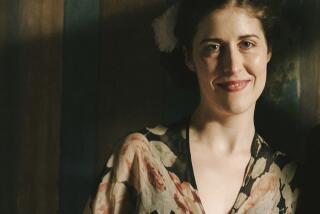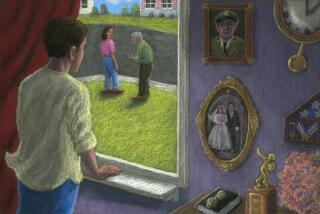BELIEVERS.<i> By Charles Baxter</i> .<i> Pantheon: 288 pp., $23</i>
Charles Baxter, known for the wisdom in his fiction and the feelings evoked by his prose, may be thought of as an artist only of the spirit, responding, say, to the season, to a perceived mood, to the smell of the river or the light in the sky. But this collection of seven stories and a novella will remind us that he is an exemplary writer because he works in persuasive solidities, in what is actual, in what, when dropped into water, displaces it up and into the air.
So, of his protagonist Kit in the story âThe Cure for Love,â Baxter writes: âBecause spring had hit Chicago, and sunlight had given this particular Saturday morning a light fever, and because her black mood was making her soul sore, she decided to get on the Chicago Transit Authority bus and read Ovid while she rode to the suburbs and back.â
A morning with âa light feverâ caused by sunlight? A woman whose soul is âsoreâ because of her black mood?
You arenât certain, but you think Baxterâs right. Youâve known mornings when sun along the sidewalk or up the trunk of a tree has made you blue, and arenât the blues what you have on a morning with a light fever? So you read along, but itâs not that simple. You cannot not read along with Baxter. And then he has you, for he is a master of whatâs actual and he shows you âa smudgy semi-clean windowâ on the bus, the âtattered jackets and gummy spotted clothesâ of passengers, the âhollow and stoned and vacant-eyedâ people who sit around Kit, âmen who worked in carwashes, women who worked in diners.â
As in the beginning of another story, âReincarnation,â where he writes, âthe last of the light flowed through the west windows over the radiators, and over the boards on the radiators, and the house plants on the boardsâ--he creates his imagery from stuff, the things of the world, actual-seeming objects, which fiction writers note and from which they build moments and people.
Baxter understands how (in âThe Cure for Loveâ) a woman may conduct a dialogue with Ovid and find Lake Michigan âabjectly picturesque,â but he is never content to reside in the abstract. His characters are creatures of the solid world, and Kit, riven by love and by loss, standing stunned on the street in Chicago, her wild bus ride done, nevertheless cannot help noting a mad old woman with only one lens in her glasses and the reflection in that lens of an orange neon light.
Baxter is a student of light (among his novels: âFirst Lightâ and âShadow Playâ), and he makes lovely language of it. In âSaul and Patsy Are in Labor,â a newborn babyâs expression, along with a nurseâs smile, âsunspotâ near the motherâs heart; âthe huge overhead delivery room light goes out, like a sigh.â He creates the language: the noun âsunspotâ becomes a verb, while a visual image, the light on the ceiling, goes out in audile terms. We know that breezes make a sail flap or luff, but it is Baxter who sees how light, through curtains, comes âluffing in the window.â The language he makes is not precious or academic. It is right. Only the great chefs know how to combine, as Baxter combines the effects of the senses, the sweet with the sour, the fierce with the cool, the visual with the auditory.
And he is a student of opposing elements. In story after story, we find the world of the characters divided. These are contemplative, self-studying characters who look up to find themselves caught in a moment that they know, if they can seize it, will define them. And they work hard to capture themselves. In âThe Next Building I Plan to Bomb,â one character says that he works in a bank and he knows that âif youâre harmless you get killed and eaten.â Another character replies, âThatâs back in the country of acting out,â and the terms of division are declared. âThe Cure for Loveâ divides Kitâs world into the life of those who are at home as opposed to the life of those who are in exile. In âTime Exposure,â Irene sees a world of apocalyptic bedlam set to rest by the birth of her children: âAll that prized calamity was just another story.â In the novella, âBelievers,â the narrator says of his father, a former priest, that God left him. âAnd my father was given this world, the one we live in, for all the good it would do him.â Every world in this book is divided, as the thoughtful characters are divided against themselves.
The bookâs self-scrutinizers, those who believe and those who cannot--whether in God, love, their own sexuality or the gift that is the world--are the middle class in the middle of the nation. These are Michigan stories, and they occur in the lives of those with intelligence, leisure in which to use it, walls behind which they may retreat and time enough for contemplation. In âReincarnation,â the narrator asks, âWas this bourgeois, this topic? Sure.â A few pages later, the narratorâs wife asks, âWhy do middle-class people like us talk so much about incarnation and reincarnations?â Saul in âSaul and Patsy Are in Laborâ considers that to him, âfatherhood is one long unrewritable bourgeois script. Love, rage and tenderness disable him. . . .â In âFlood Show,â a man crippled by love and loss is met on the highway by the largest metaphor of middle-class life to roll into ken in a short story: âthere comes into view . . . an old wooden two-story house on an enormous platform truck, squarely in the middle of the road, blocking them.â The protagonist âlooks up and sees what he knows is a bedroom window. He imagines himself in that bedroom.â
And that involuntary act of the imagination is the key to these characters, their common denominator and an index of Baxterâs brilliance. Like us, they give in to the frailties; like us, they express themselves, from time to time, as failures of will, of nerve, of ethics, of feeling. But--and this is the faith Baxter espouses in âBelieversâ and the assurance his work lends--they are like us in that their souls do not only sink: They strive to climb. And whether we know how to pray or not, or know to whom we might pray, or know that we ought to, âweâre the missionaries they left behind when they took all the religion away,â Patsy, the new mother, thinks to herself. An instant before her husband, whoâs been scrabbling in the mud, kisses her, she thinks, âDirt is attached to his lips.â In this world of secular faith, dominated by materiality, bereft of a comforting God, its men, women and children, knowing they are made of clay and oddly comforted by the knowledge and by that composition, yearn to learn to accept themselves.
The title novella deals most directly, in traditional-seeming terms, with matters of faith. It is the effort of a son to learn about--to become, I would say--his father, a handsome priest of courageous faith who was seduced away from certainty and into the beautiful perils of the flesh, as well as the darkest ferocities of the spirit. Baxter gives us a fine sense of Germany in 1938 and of a couple who are memorable, careless American fascists. Of the beautiful wife, the narratorâs father thinks, âHow odd she would be, if she ever discovered she had a soul. Sheâd probably try to sell it, first thing,â and we are back to the bourgeoisie and our battle to not become the materiality that seems to define us. The novella is not only fascinating: It is a lesson for writers in how to use the first-person point of view; it demonstrates to its readers how acts of the imagination are made to occur.
âBelieversâ is also a source of simply gorgeous prose: âMy father sits in utter silence and it is there that I go to see him.â But every page that Baxter writes is such a source, as is his every story a lesson in observation, feeling and wit.
Of one of his characters, Baxter writes, âIn the spiritual mildew of the Midwest all winter he lives stranded in an ink drawing.â But to see that trap of black and white, you need good light. Baxter shines on even his darkest characters like a summerâs pulsing Middle Western sun.
More to Read
Sign up for our Book Club newsletter
Get the latest news, events and more from the Los Angeles Times Book Club, and help us get L.A. reading and talking.
You may occasionally receive promotional content from the Los Angeles Times.








